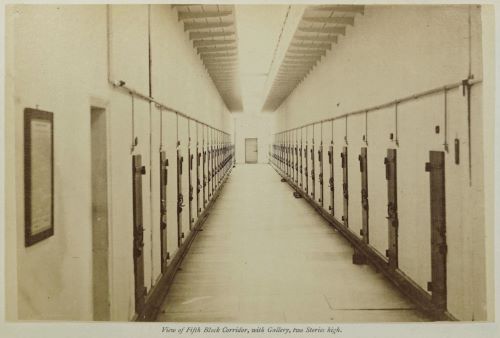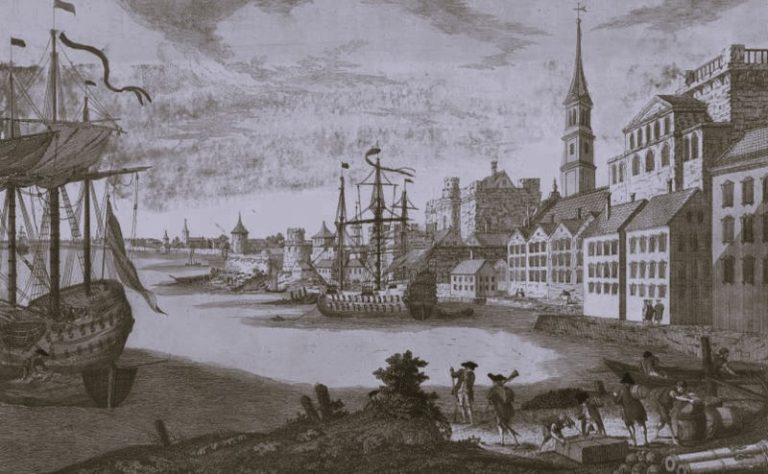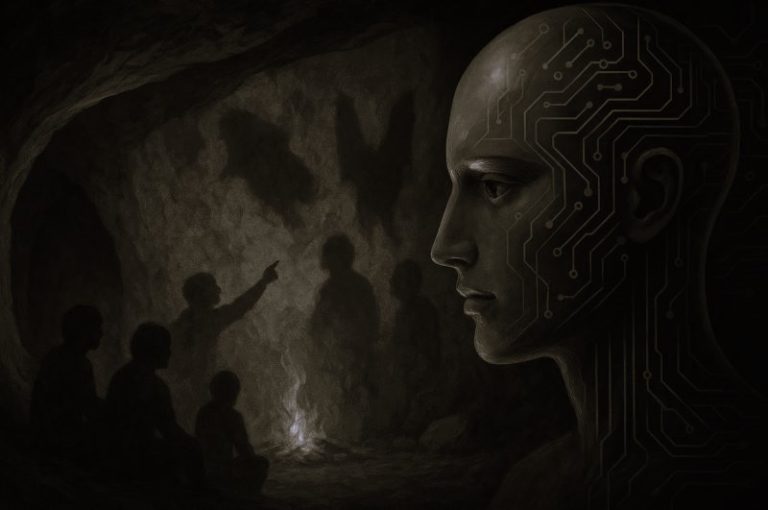

Solitary confinement was originally developed from Quaker ideas about the redemptive power of silence.

By Dr. Jane Brox
Author and Historian
This article, The Silent Treatment: Solitary Confinement’s Unlikely Origins, was originally published in The Public Domain Review under a Creative Commons Attribution-ShareAlike 3.0. If you wish to reuse it please see: https://publicdomainreview.org/legal/
On any given day in the United States, of the more than one million men and women incarcerated in jails and prisons, over 120,000 are locked in solitary confinement.1 None have been sentenced by a court to their isolation. They are serving a punishment within punishment, having been placed in solitary by prison officials for a variety of reasons: violent crime, petty theft, speaking out, gang involvement, political activism. Some are in protective custody; others have mental health issues and are considered too difficult to control. A disproportionate percentage are people of color. Their sentence might last weeks or months and is subject to extension. More than a few spend years, even decades in cells whose dimensions are commonly compared to the size of a parking space, but which are often smaller — six-by-nine feet, or eight-by-ten. Reading material is sparse. Confined prisoners don’t participate in educational or rehabilitation programs. Other than meals — which are often more meager than those provided to the general prison population — and an hour of exercise a day, little exists to distract them from the heaviness of time, and nothing at all suggests that the historic roots of such punishment can be traced to the concept of redemption.
The idea of the solitary cell as an integral part of the American prison system arose during the Early Republic, the specific vision of Philadelphia physician and Founding Father Benjamin Rush, who advocated for time in solitude and silence — the active, searching silence of Quakerism — as an alternative to the bodily pain, injury, and humiliation of public hangings and whippings. He saw it as a means not only of punishment but of reformation for housebreakers, forgers, highway robbers, horse thieves, and even murderers, and his vision of justice eventually led to the construction of the world’s first penitentiary, Eastern State, designed by architect John Haviland, and raised on the grounds of an old cherry orchard three miles outside of Philadelphia’s city limits.


When Cherry Hill — as it was sometimes called — admitted its first prisoners in 1829, it stood in stark contrast to traditional jails, where debtors and those awaiting trial were housed in filthy, noisy, and disorderly common rooms. In the penitentiary, not only were the confined to remain in their individual cells for the duration of their sentence, according to the board of inspectors for Philadelphia’s prisons, there was to be “such an entire seclusion of convicts from society and from one another, as that during the period of their confinement, no one shall see or hear, or be seen or heard by any human being, except the jailer, the inspectors, or such other persons, as for highly urgent reasons may be permitted to enter the walls of the prison.”2
Rush began to articulate his ideas concerning justice more than forty years prior to Eastern State’s opening. During the winter of 1787, in Benjamin Franklin’s Philadelphia home, he addressed the newly formed Society for Promoting Political Inquiries, which was comprised of a dozen or more men — Thomas Paine among them — who’d begun to routinely gather to discuss ideas meant to foster social and economic improvements in Pennsylvania and throughout the young Republic. “I cannot help entertaining a hope, that the time is not very distant, when the gallows, the pillory, the stocks, the whipping-post . . . will be connected with the history of the rack and the stake, as marks of the barbarity of the ages and countries, and as melancholy proofs of the feeble operation of reason and religion upon the human mind”, he declared.3
At the time, Philadelphia had already begun to search for alternatives to the public, provocative blood punishments and the notorious chaos of its overcrowded jails. Most notably, city officials were experimenting with having felons undertake public works projects such as building, maintaining, and cleaning the streets. The felons, known as “wheelbarrow men”, wore brightly colored or boldly striped uniforms, which were meant both to humiliate them and to help identify them should they escape. They attracted crowds — some taunting them, others throwing coins in support and solidarity. Some felons escaped, and some escapees attacked citizens. Both their perceived threat to the public and their degradation created unease, for the wheelbarrow men made punishment publicly apparent in an even more emphatic way than had felons held in stocks or tied to whipping posts: “They were encumbered with iron collars and chains, to which bomb-shells were attached, to be dragged along while they performed their degrading service, under the eye of keepers armed with swords, blunderbusses, and other weapons of destruction”, noted Roberts Vaux, one of the city’s most dedicated promulgators of penal reform.4

Rush had the wheelbarrow men foremost in mind at Franklin’s home that winter evening. Historian David Freeman Hawke even suggests that an encounter with wheelbarrow men fostered Rush’s interest in reform of the justice system. He’d seen a group of them sweeping his street, and offered them something to drink. While talking to them, he found that, as Hawke notes, “he had sympathy, perhaps even respect, for the way they bore their humiliation.”5 Rush insisted to his audience that
All public punishments tend to make bad men worse, and to increase crimes by their influence upon society. . . . But may not the benefit derived to society, by employing criminals to repair public roads, or to clean streets, overbalance the evils that have been mentioned? I answer, by no means. On the contrary . . . the practice of employing criminals in public labour, will render labour of every kind disreputable.6
The spectacle trivialized both criminal and onlooker, he argued, and tended to “make bad men worse” especially by destroying any sense of shame. It was no better than the blood punishments which also failed to create a true change of mind and habit: “A man who has lost his character at a whipping-post, has nothing valuable left to lose in society.”7 Such measures, Rush insisted, also harmed those who witnessed them:
The men, or perhaps the women whose persons we detest, possess souls and bodies composed of the same materials as those of our friends and relations. They are bone of their bone; and were originally fashioned with the same spirits. What, then, must be the consequence of a familiarity with such objects of horror, upon our attachments and duties to our friends and connections, or to the rest of mankind?8
In addition to decrying traditional methods of punishment, Rush offered specific proposals for a penitentiary in which silence would be put toward many ends — ideas that were inextricable from the city’s Quaker roots. Silence in Philadelphia held a profound and specific meaning that harked back to its first days as a settlement. In the spare simple spaces of the meeting houses, Quakers gathered and waited and listened together for the presence of the divine, for a voice that could only be heard in passive, expectant, and profound silence: “By not speaking, not desiring, and not thinking, one arrives at the true and perfect mystical silence, wherein God speaks with the soul”, explained seventeenth-century Italian priest and Quaker inspiration Miguel de Molinos.9

Not only did silence have a particular meaning in Pennsylvania, justice did as well. William Penn, in his new colony, was concerned with fostering a humane and fair means of dealing with transgression, a belief born of experience. As a convert to Quakerism he’d had hard experience with both the jails and courtrooms of London. Since the founding of the religion by George Fox in the 1640s, Quakers had been subject to persecution. In the late seventeenth century, after Charles II passed a set of acts that attempted to weaken dissent and protect the Church of England, besides being stocked, stoned, and whipped, more than thirteen thousand Quakers were imprisoned in England. Hundreds died while incarcerated.
Penn’s Great Law — a series of statutes by which the Colony was to be governed — aimed to ensure the procedures for trial and sentencing in the Pennsylvania colony would be simple, understandable, and equitable. Although the blood punishments didn’t disappear, they were fewer and milder than those in England and in the other colonies. The death sentence was abolished for all crimes except premeditated murder, which was in accord with predominant Quaker thinking on capital punishment. In Penn’s colony, every county prison was to be a workhouse, and felons were either to be fined or sentenced to a certain amount of time at hard labor in a “house of Correction”.
Still, Penn’s laws, though less severe, were based on traditional means of carrying out justice. What Rush proposed was innovative, and in the years following his speech, he more fully articulated specific ideas for the penitentiary. While he emphasized the possibilities of reformation, the horror of confinement was an inextricable component of his vision. The secrecy and sense of the extreme fostered by an isolated location and an austere aura of gloom would work to magnify the wages of such punishment in the public mind. For the prisoner, those same qualities would work to make society feel dear once again. “An attachment to kindred and society is one of the strongest feelings of the human heart”, insisted Rush.10 “A separation from them, therefore has ever been considered as one of severest punishments that can be inflicted upon man. . . . Personal liberty is so dear to all men, that the loss of it, for an indefinite time, is a punishment so severe that death has often been preferred to it.” To counter the dread of an indefinite sentence — commonly endured by debtors and felons awaiting punishment in the jails of the time — Rush advocated terms of specific duration. And he held firm to the notion that silence in solitude would inevitably be redemptive: “I already hear the inhabitants of our villages and townships counting the years that shall complete the reformation of one of their citizens”, he proclaimed.11 “I behold them running to meet him on the day of his deliverance. His friends and family bathe his cheeks with tears of joy; and the universal shout of the neighborhood is, ‘This our brother was lost, and is found — was dead and is alive.’”
There had been, prior to the construction of the penitentiary, some partial measures toward reform through solitude and silence in Philadelphia. In 1790 the Pennsylvania Legislature, looking for ways to alleviate the crowding in jails, approved funding to remodel the city’s Walnut Street Jail. When opened in 1773, as was typical at the time, the general prison population was housed together in large rooms, debtors and felons alike fending for themselves. Under the remodeling plan — advocated by the Philadelphia Society for Alleviating the Miseries of Public Prisons, of which Rush was a founding and influential member — in addition to other changes, a separate building was erected on the prison grounds, with sixteen eight-by-six-foot cells designated for the solitary confinement of serious and repeat offenders. This was in keeping with Rush’s proposal first articulated in Franklin’s living room that cells be “provided for the solitary confinement of such persons as are of a refractory temper.”12 The Walnut Street Jail eventually came to be known as “the cradle of the penitentiary”.

In general, by the late eighteenth century the country’s attitude toward the blood punishments was changing, and many states were shifting from brandings and whippings to extended confinements for convicts, but no solitude in these prisons was complete. At Auburn, in New York, for example, inmates were housed in solitary cells, but they ate meals together and worked together in enforced silence. Nor was redemption the aim in these houses of incarceration. In fact, the conditions were often entirely brutish. For instance, at New-Gate, Connecticut’s first prison, the incarcerated were housed underground in the tunnels of a depleted copper mine. They were brought to the surface every day to work in shops forging nails or building barrels and casks.
Although Rush would always emphasize the idea of the prison cell as a means of reformation, there was little consensus, even in Philadelphia, as to the purpose of incarceration. “There have been many opinions about the mode of treating the convicts”, remarked Caleb Lownes, the first administrator of the reconceptualized Walnut Street.13
Some seem to forget that the prisoner is a rational being, of like feeling and passions with themselves. Some think he is placed there to be perpetually tormented and punished. Some prescribe a certain time as necessary to his cure. One will not allow him the light of heaven, or the refreshment of the breeze; the comforts of society, or even the voice of his keeper: while another considers a seclusion from his friends and connexions, as a ground for accusation of inhumanity.
At Walnut Street, he noted, they “adopted a plan, which upon full consideration was deemed best, though not perfect.” Lownes further remarked that the prisoners knew that a “second conviction would consign them to the solitary cells, and deprive them of the most distant hopes of pardon. These cells are an object of real terror to them all.”14 The solitary cells weren’t only distinguished in prisoners’ minds. As sociologist Orlando Lewis has noted, they were “at the outset branded in the public mind as punishment cells for the protection of society and the infliction of the hardest possible sentences.”15
Eastern State Penitentiary certainly appeared to be designed for punishment. Its aspect was nothing if not forbidding. The ranges of solitary cells radiating out from a central rotunda were surrounded by a thirty-foot-high wall built of hewn Schuylkill stone. The original entryway stood twenty-seven feet high and fifteen feet wide, and its oaken double doors, studded with iron rivets, weighed several tons. A massive wrought-iron portcullis fronted them. Benjamin Rush did not live to see his vision fully play out: he died in 1813, a decade before construction of Eastern State began. Yet within those walls of stone his concept of the silent, solitary cell as a means of reformation for all prisoners — be it a first-time petty thief or an intransigent and violent perpetrator of assaults — survived, at least in theory.


Prisoner No. 1, Charles Williams, passed through the portal of the still-to-be-completed penitentiary on October 22, 1829.16 The eighteen-year-old Black farmer was sentenced to two years of solitary and silent confinement for breaking into a house and stealing a silver watch, a gold seal, and a gold key worth, in total, $25.00 (about $830.00 in today’s money). His entry ritual in the penitentiary’s central rotunda was meant to be a kind of baptism. After he had his hair cut, he was issued two handkerchiefs, two pairs of socks, a pair of shoes, woolen trousers, a jacket, and a shirt. His identity as Prisoner No. 1 was sewn into his clothing and hung above the entrance to his cell. He would not be called Charles again for the duration of his stay.
He was meant never to know where in the penitentiary his cell was located — while being ushered to it, Williams was hooded. All he was to comprehend of his physical world was the twelve-by-eight-foot whitewashed cell he inhabited: its stone floor; the bed, which could be folded against the wall for more room, with its sheet, blanket, and straw mattress; some scrubbing and sweeping brushes; a clothes rail; a wash basin; a mirror; a crude flush toilet; a tin cup; a victuals pan; a stool; and a workbench where he was to spend his time making shoes. Light from a small ocular window cut into the ceiling was deemed sufficient for his work and for reading the Bible. The window was known as the Eye of God, although architect John Haviland referred to it as a Dead Eye, which could be darkened by placing a half keg over it should a prisoner need to be disciplined. Charles Williams’ individual exercise yard adjoining his cell, and, nearly identical in size to it, was walled in stone. There, for one hour a day, he could look up at a patch of sky.
Williams wouldn’t be able to receive or write letters. Although he might exchange occasional words with a guard or inspector, and he’d have regular visits from moral and spiritual instructors, no friends or family would be allowed to visit him. He was not to talk unless instructed to. He was not to make any unnecessary noise. The guards patrolling the hallways wore socks over their boots to muffle their footsteps. A prisoner would never know when a guard was approaching the peephole in his door, and so always had to expect he was being watched. Likewise, the wheels of the meal cart were fashioned of wool, which caused no perceptual sound when rations were delivered. The food was meant to be plentiful and nourishing: coffee or cocoa in the morning, one pound of bread a day, potatoes and meat at noon, a type of corn pudding called “Indian mush” in the evening. Each prisoner was granted a half-gallon of molasses each month, and could ask for salt. He’d be given vinegar as a favor. (When Eastern State opened, the poorest city dwellers lived in lightless basements, and officials feared that the eight-by-twelve-foot cell and the guarantee of three meals a day might prove attractive.)


In today’s isolation, the food is not only often meager but unappetizing, with few fresh fruits and vegetables, and bread that is often soggy, sometimes moldy. The noise is unceasing. Random cries and howls. Screams. Rattling. Banging. Shouting. Buzzers and alarms. At Eastern State, prisoners resorted to furtive tappings and notes passed over the walls of their exercise yards to communicate with one another. Now there is fishing — a means of passing a note to an adjoining cell by attaching it to a weighted string and slipping it underneath the cell door. The shadows in a cell lit only by a small round window are gone. In keeping with modern times, an excess of harsh artificial light floods solitary cells. Sometimes it isn’t even shut off at night.
Still, an inmate who has spent time in twenty-first century isolation would recognize the dimensions of Charles Williams’ cell, and its toilet, sink, and narrow bed against the wall. And its lack of privacy. A modern inmate may be continually monitored by video feed, which only increases the feeling expressed hundreds of years ago by the Marquis de Lafayette upon seeing Eastern State for the first time: “none have exceeded — none have equaled that single oppression of being . . . exposed to the view of two eyes, watching my every motion, taking from my very thoughts every idea of privacy.”17 Although those in modern-day isolation don’t work, anyone who knows about surviving carceral isolation would certainly understand why some prisoners in Eastern State voluntarily rose before daybreak and began to hammer their leather. As prisoners’ rights advocate and writer Keramet Reiter observes, the inmates who do best in solitary “develop rigid, repetitive routines to get through the long days.”18 Exercise, preparing legal documents, reading, learning a language.
And they would understand just how unprepared Charles Williams must have been for the world he was released into exactly two years to the day after he’d been ushered to his cell. His original clothes had been returned to him, as had his name. He had gained some skills as a shoemaker, and prison officials had given him four dollars, “whereby the temptation immediately to commit offenses against society, before employment can be obtained, may be obviated”, but such things would be of limited help in a world that had surely grown strange to him.19 It’s not likely Williams would have had any word from his family during his confinement. No gossip or news from the outside. He’d know nothing of the inventions or cholera outbreaks or prominent deaths of the past two years. And it’s doubtful that anyone was running to meet him on the day of his deliverance.
Upon his release in October 1831, Eastern State Penitentiary was still not completed, and was not yet full, although it soon became clear that the original plan for seven ranges of cells housing three hundred prisoners was not large enough for the future, so John Haviland revised his design to include more ranges. He added a second story to some of them. Once Eastern State was finally finished in 1836, it could house 586 prisoners in individual cells. Even so, within a few decades, Rush’s concept of redemption through silence and solitude was lost to the exigencies of a system contending with exponential growth and social change. After the Civil War, the demand for space outgrew the complex’s capacity, and the warden had no choice but to double up prisoners in the cells. By the last decade of the century, half of the prisoners had cellmates and there were communal workshops on the grounds. During the twentieth century: a prison newspaper, baseball teams, boxing matches.
Eastern State housed its last prisoners in 1971. By then, the city of Philadelphia had long grown around its walls of Schuylkill stone. Today the penitentiary remains in a state of preserved ruin. Visitors can peer into mockups of the cells as they were in Charles Williams’ time. They can also descend beneath one of the ranges to view four solitary cells constructed in the 1920s — by then Eastern State had become a fully congregate prison — for the purpose of punishment within punishment. They had been carved out of an underground tunnel. No beds. No workbench. No plumbing. No windows. What electric light there was would have been controlled by the guards. In their ruin those four cells now stand for all that became of Rush’s hope for a system to replace the barbarity of the ages.
Appendix
Endnotes
- For statistics on contemporary prisons and solitary confinement, see Calculating Torture: A Report by Solitary Watch and the Unlock the Box Campaign, May 2023: available here.
- Journal of the Senate of the Commonwealth of Pennsylvania, vol. 31 (Harrisburg, PA: William F. Buyers, 1820), 339.
- Benjamin Rush, “An Enquiry Into the Effects of Public Punishments Upon Criminals, and Upon Society”, in Essays, Literary Moral and Philosophical, ed. Michael Meranze (Schenectady, NY: Union College Press, 1988), 94.
- Roberts Vaux, Notices of the Original, and Successive Efforts, to Improve the Discipline of the Prison at Philadelphia (Philadelphia: Kimber and Sharpless, 1826), 22.
- David Freeman Hawke, Benjamin Rush: Revolutionary Gadfly (New York: The Bobbs-Merrill Company, Inc., 1971), 364.
- Rush, “An Enquiry”, 80.
- Ibid.
- Ibid., 84.
- Miguel de Molinos quoted in Richard Phillips, Concise Remarks on Watchfulness and Silence (London: W. Phillips, 1815), 8.
- Rush, “An Enquiry”, 87.
- Ibid., 90.
- Rush, “An Enquiry Into the Effects of Public Punishments Upon Criminals, and Upon Society”, quoted in Michael Meranze, Laboratories of Virtue: Punishment, Revolution, and Authority in Philadelphia, 1760-1835 (Chapel Hill: University of North Carolina Press, 1996), 87.
- Caleb Lownes, An Account of the Alteration and Present State of the Penal Laws of Pennsylvania, Containing Also an Account of the Gaol and Penitentiary House of Philadelphia (Boston: Young & Minns, 1799), 12.
- Ibid., 12.
- Orlando Lewis, The Development of American Prisons and Prison Customs, 1776-1845 (Montclair, NJ: Patterson Smith, 1967), 26-27.
- For facts on Charles Williams’ incarceration and the structure of the Penitentiary, see Negley K. Teeters and John D. Shearer, The Prison at Philadelphia, Cherry Hill: The Separate System of Penal Discipline: 1829-1913 (New York: Columbia University Press for Temple University Publications, 1957), 62-64, 71, 75-77.
- Marquis de Lafayette quoted in Negley K. Teeters and John D. Shearer, The Prison at Philadelphia, 28.
- Keramet Reiter, 23/7: Pelican Bay Prison and the Rise of Long-Term Solitary Confinement (New Haven, CT: Yale University Press, 2016), 25.
- Quoted in Negley K. Teeters and John D. Shearer, The Prison at Philadelphia, 135.
Public Domain Works
- An Enquiry into the Effects of Public Punishments upon Criminals and upon Society, Benjamin Rush (c.1787).
- Memorandum of a Late Visit to the Auburn Penitentiary, Frederick Adolphus Packard (1842).
- Letter on the Penitentiary System of Pennsylvania, Roberts Vaux (1827).
- A View and Description of the Eastern Penitentiary of Pennsylvania (1830).
- Buds and Flowers, of Leisure Hours, Harry Hawser (1844).
- Brief Sketch of the Origin and History of the State Penitentiary for the Eastern District of Pennsylvania, Richard Vaux (1872).
Further Reading
- Silence: A Social History of One of the Least Understood Elements of Our Lives, by Jane Brox
- 23/7: Pelican Bay Prison and the Rise of Long-Term Solitary Confinement, by Karemet Reiter
- The Deviant Prison: Philadelphia’s Eastern State Penitentiary and the Origins of America’s Modern Penal System, 1829–1913, by Ashley T. Rubin






